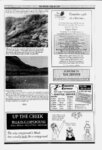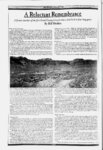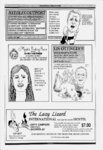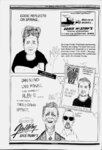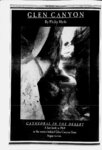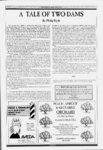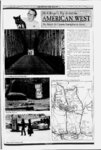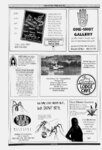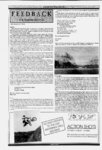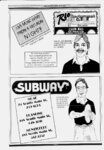| OCR Text |
Show Integrity 6 the US. Forest ServicePart 4 THE WAR ON SCENERY By Owen Severance The fourth installment of this series discusses the Forest Service's "Visual Management System" and the contempt that Forest Supervisor Janette Kaiser and MoabMontkeUo District Ranger Glen Cassamassa have shown for scenic values on the Forest. The uglification of the Manti-LaSNational Forest has continued as the Forest Service Forest. Even though the public places a high value of the its gpal pursues commercializing on scenery, Kaiser and Cassamassa have not bothered to discuss the visual impacts of commercial uses of the Forest in a public forum. Have the faceless Forest Service bureaucrats with names like Darwin Jensen, Gary Reynolds, or Mark Sommer asked you if the scenic views on the National Forest should be protected? Of course not. Theoretically, Forest Flan should the Visual Quality Objectives that are mandated by the Manti-LaSthe Forest Service has values. scenic for the Forest's However, provide adequate protection In order to understand Visual decided to either ignore or change those Quality Objectives. what they are doing, some background information on National Forest "scenery management" is needed. The several volumes in the "National Forest Landscape Management" manuals provide the guidelines for determining how the views of the National Forest should be managed. Volume 2, Chapter 1, "The Visual Management System" is used to determine the "Visual Quality Objectives" for the various areas of the Forest The intent of this section of the manual is stated in the Introduction: "The American people are concerned about the "Maximum Modification which provides for vegetative and land form alterations that may dominate the characteristic landform; however, those alterations should appear as a natural occurrence when viewed from a distance of more than five miles. No areas on the Moab and Monticello Ranger Districts have an inventory VQO this low. al al "Unacceptable Modification" is not a Visual Quality Objective. This category recognizes past activities that should not have been allowed. Massive road cuts through solid rock and obvious dearcuts are examples. The chained areas on the southeast side of the LaSals fall into this category. Once the Inventory VQOs are established, they are used to determine the Visual Quality Objectives in the Forest Plan. While some Forests use the Inventory VQOs as the Forest Flan VQOs, the Manti-LaSNational Forest did not With one exception, a massive Visual of the downgrade Quality Objectives took place on the Moab and Monticello Ranger Districts when the Forest Flan was finalized in 1986. All of the foreground views (the area within one half mile) along the primary Forest roads were downgraded from "Retention" to "Partial Retention" on both Ranger Districts. In addition, all of the views of the mountains on the Monticello Ranger District were downgraded from "Retention" to "Partial Retention." Numerous other downgrades also occurred all supposedly in the name of "management flexibility." The result is an inadequate level of protection for the Forest's al Xaiscr and Cassamassa turned their attention to Abajo Peakvhere they decided to declare war on the scenic values of the Blue Mountains.Until a few years ago. all the towers were guyed towers and therefore not obvious from Monticello and US 19L Then the Forest Service allowed two 100 foot tall towers to be constructed in violation of the Forest Plan and without the preparation of an Environmental Assessment. (Now they propose to add SEVEN MORE TOWERS, ranging in height from 60 to 150 feet.) self-supporti- ng quality of their visual environment. Because of this concern, it has become appropriate to establish the "visual landscape" as a basic resource, to be treated as an essential part visual landscape, especially on the Monticello Ranger District. of and receive equal consideration with the other basic resources of the land." Unfortunately this concept has not been accepted by Janette and Glen. Over the years, the Forest Service has allowed many activities that do not meet the Forest Plan's Visual Management Objectives. Recent activities center on communications sites. The Bald Mesa Communications Site on the LaSal Mountains is one example. The construction of antennas that can't meet the area's Partial Retention VQO has been allowed by the Forest Service. The primary reason the VQO hasn't been met is the use of towers that do not use guy wires; they need to be much more massive than "guyed" towers and therefore have much greater visibility. The Forest Service admits that the towers on Bald Mesa do not meet the Partial Retention VQO (the Forest Service says that they meet the lower "Modification" VQO). When the Environmental Assessment was prepared to formally designate a Bald Mesa Communications Site in 1995, the Forest Service refused to require the eventual change from towers to less noticeable guyed towers. Instead, they mandated that all new towers be towers, guaranteeing that the Bald Mesa Communications Site will be a permanent eyesore. Their flimsy excuse for doing this was a claim that guy wires are a safety hazard. The Visual Quality Objective remains Partial Retention even though the Forest Service admits that the communications site will never meet this VQO. Janette Kaiser's reason for not changing the VQO to Modification was allegedly to avoid "spot zoning;" and, by keeping the Partial Retention VQO, the Forest Service would have an incentive to keep the visual quality from deteriorating further. In other words, the Forest Service is pretending that the communications site is not an eyesore. By spot zoning the Bald Mesa Communications Site with a VQO of Modification, the Forest Service would have formally admitted a lack of concern for protecting the visual the landscape. However, phrase "spot zoning" misrepresents what results. By degrading one part of a scenic view, all of that view is degraded - lowered visual quality in the middle of a scene reduces the visual quality of all of the view to the lower level. A "Visual Resource Inventory" is undertaken on each National Forest to determine "Visual Quality Objectives" that are based on the landform and the public's concern for scenic quality. This inventory results in visual "zones" that can be managed for the appropriate level of visual resource protection. The available "VQOs" are: "self-supportin-g" self-supporti-ng "Preservation" which is used in areas with special classifications and allows for ecological changes only. The only local examples are the Dark Canyon Wilderness Area on the Monticello Ranger District and the upper parts of Mt Peale, Mt Mellenthin, and Mt. Tuckuhnikivatz on the Moab Ranger District. "Retention which provides for management activities which are not visually evident Examples are all of the mountain peaks on both Ranger Districts. "Partial Retention" which provides for management activities that remain visually subordinate to the characteristic landscape. Examples are areas with less than outstanding landscape features or areas along secondary Forest roads. Many timber sale areas have a Partial Retention Visual Quality Objective. "Modification which provides for management activities that may visually dominate the as a original characteristic landscape; however, the management activity should appear natural occurrence when viewed from distances from dose up to about five miles. Examples are roads and structures. ng self-support- |




